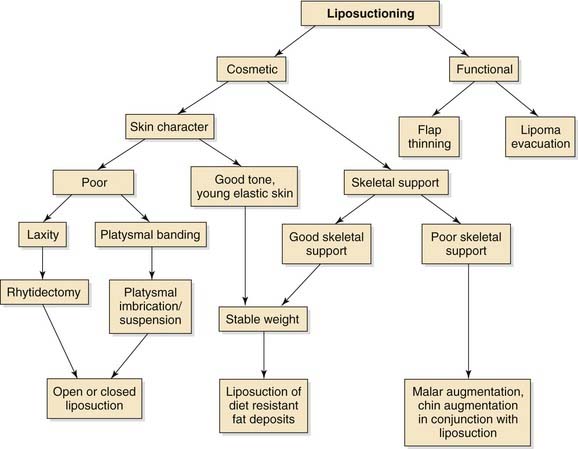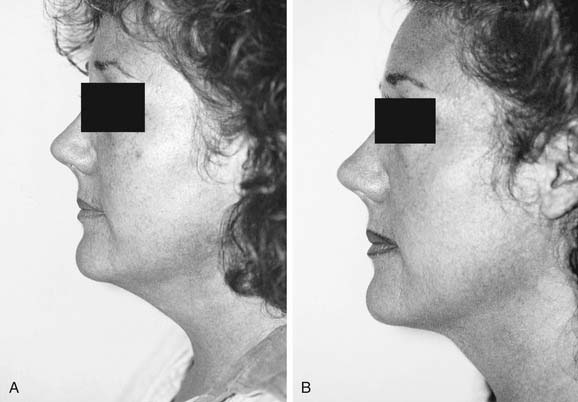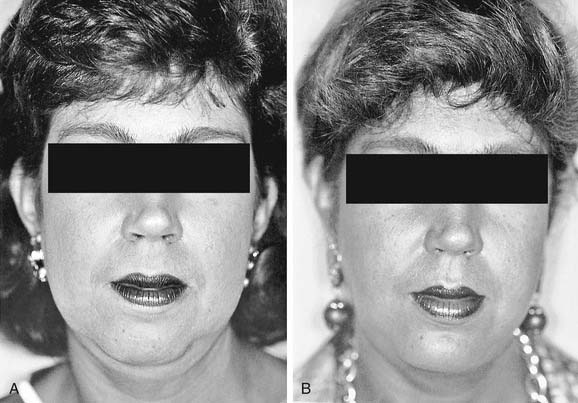CHAPTER 31 Liposuction
Suction lipectomy is an effective means of recontouring the face that has been popularized and refined over the past 30 years.1–5 As with all cosmetic surgery, understanding the anatomy, physiology, and changes that result from the aging process is imperative. On the basis of these changes, a logical approach to the integration of suction-assisted lipocontouring into the practice of facial plastic and reconstructive surgery is possible (Fig. 31-1).
The distribution of body fat is a consequence of genetics and is influenced by hormones, diet, exercise, medications, and patient age. It has become apparent through tissue culture studies that, after a critical mass within an adipocyte has been reached, hyperplasia can occur.6 Although the mechanism of adipocyte hyperplasia has not yet been determined, the consensus remains that any significant change in fat deposition occurs through the enlargement rather than the addition of cells.7 Diet-resistant localized fat deposits, which are ideal for lipocontouring, may represent localized adipocyte hyperplasia. Liposuction reduces the number of adipocytes regardless of their size and therefore should yield a lasting result, unless excessive weight gain occurs. The liposuctioned regions of hypertrophy should respond to weight gain in a fashion that is similar to adipocytes in other regions of the body and, therefore, should be resistant to significant contour changes that are out of proportion with overall weight fluctuation.
Liposhaving has recently been advocated as an alternative to liposuction. In this technique, a soft tissue shaver is used with minimal suction to gently shave adipocytes.2 The safety of this technique is of concern, and further investigation is under way. With liposuction and liposhaving, preserving important structures and maintaining bridges of uninterrupted tissue between the deep and superficial layers in an effort to maintain a healthier skin flap are the principles to be followed. Ultrasonic liposuction adds the mechanical agitation of the cannula to assist in the dissection and release of adipocytes and is usually done in conjunction with tumescent infiltration.8 Recently the use of ultrasonography has been used both internally and externally to assist with liposuction. The ultrasonic energy is transferred into mechanical vibrations that cause the microcavities in the adipocytes to implode, thereby resulting in the liquefaction of the fat.9 Multiple studies have shown potential complications with the use of subcutaneous ultrasonic energy resulting from heat generated at the cutaneous incision site and the more distal subdermal sites.8–10 To date there are no controlled studies that demonstrate any added benefit from ultrasonic-assisted liposuction in the face and neck as compared with the standard technique.
Patient Selection
One of the greatest challenges with facial plastic surgery is the art of proper patient selection, and lipocontouring is no exception. Patient selection begins with an informal interview to get a sense of the patient’s motivation, expectation, and cooperation. The patient’s motivation for pursuing a cosmetic procedure should be investigated. Some patients expect a change in external appearance to have a significant impact on their personal or professional lives (e.g., to get a promotion at work, to dissuade a spouse’s infidelity); these patients are bound to be disappointed. A patient’s expectations should be precise and realistic. Lipocontouring allows for the removal of a particular area of subcutaneous fullness; although it will not have a direct impact on other areas, the change in contour may create the illusion of affecting surrounding areas and thereby influence the overall balance of the face. For example, a submental lipectomy may appear to enhance chin projection (Fig. 31-2), shorten the vertical height of the face, and create a wider and more cherubic-appearing face. Likewise, facial and jaw lipocontouring may create a more angular facial contour (Fig. 31-3) but will not increase malar projection and could create a wasted appearance. The patient’s expectations should be communicated preoperatively. Computer imaging can aid in communication, but it can also be misleading if not used prudently. Cooperation is imperative during the postoperative phase. A patient who cannot avoid the sun or continue with a pressure dressing postoperatively is a poor candidate for lipocontouring and should be dissuaded from pursuing surgery.
The ideal patient is not particularly overweight and has a localized fullness that is the result of an isolated pocket of subcutaneous adipose tissue refractory to weight loss. A patient who reports a familial pattern or who has had a double chin since childhood is a good candidate. The submental, melolabial, submandibular, and buccal areas lend themselves well to lipocontouring. Younger patients tend to have greater skin elasticity, which contracts better on the new subcutaneous contour; these candidates are ideal for isolated lipocontouring. Conversely, the loss of skin elasticity and turgor in older patients will necessitate a skin-tightening procedure (see Fig. 31-17). Obese patients have excess adipose tissue in multiple layers and do not respond well to lipocontouring. Moreover, this procedure is not intended to replace general weight control.
Common Pitfalls
Patient evaluation may yield common pitfalls that lead to untoward effects:
Stay updated, free articles. Join our Telegram channel

Full access? Get Clinical Tree





